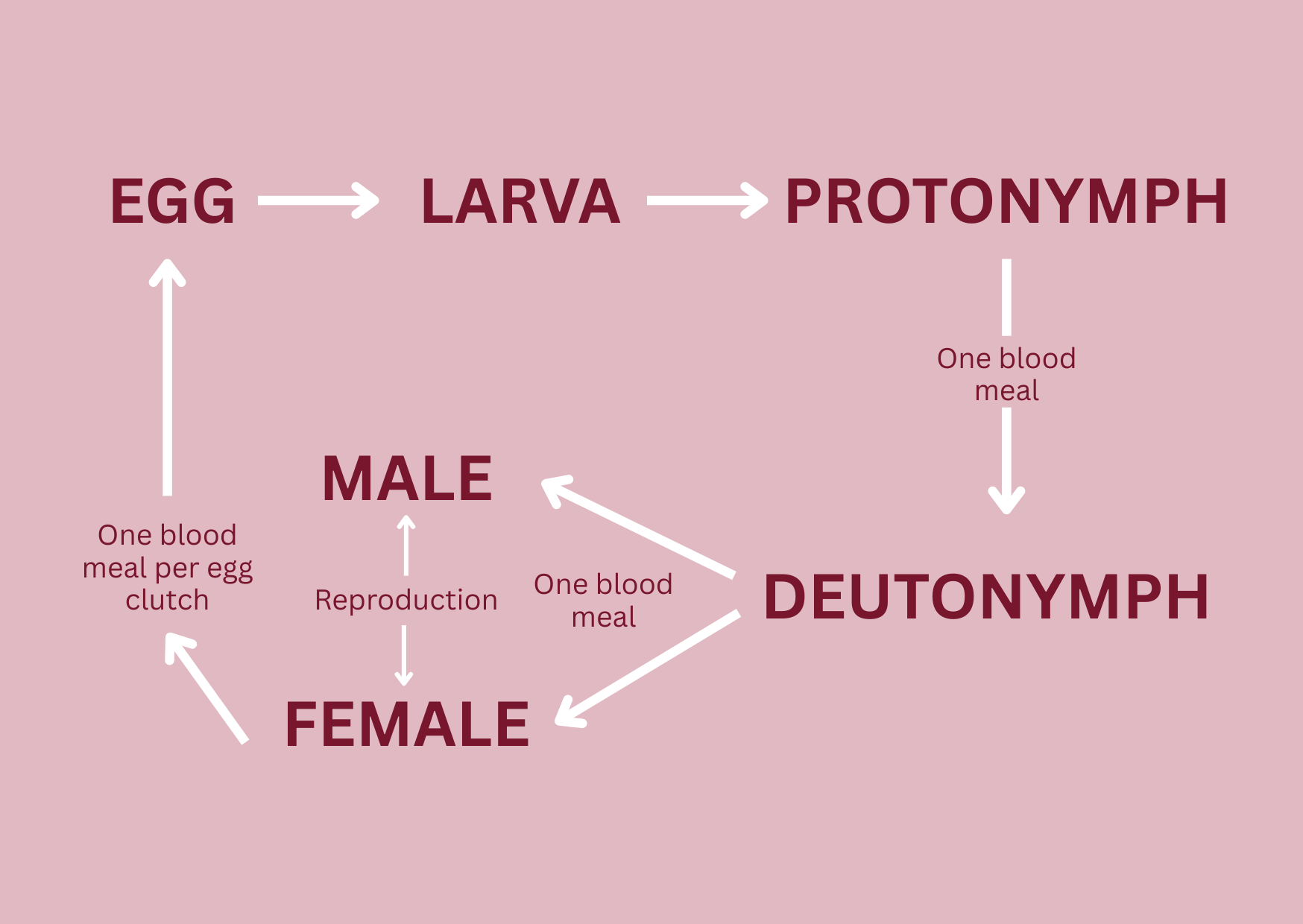A red mite (Dermanyssus gallinae) infestation can cause many negative effects on bird health and welfare.
Low numbers of red mite will cause:
- Physical irritation
- Raised stress levels
- Increased vent / feather pecking
As red mite numbers increase:
- Egg production will be affected
- Birds may become anaemic
- Mortality will rise
- Red mite can cause the spread of pathogens such as Pasteurella, Erysipelas, E.coli and Salmonella
How is red mite introduced into a house?
Wild birds – A broad range of avian species are natural hosts
The range – Red mite can survive for 9 months without a host and therefore might be present before a house is stocked. This can be from a previous flock that had an infestation
Biosecurity breach – Red mite is introduced from another infected flock. Equipment/tools that have been used in another poultry house and may harbour red mite
Life cycle of a red mite
Red mite are light sensitive, so they will emerge at night to suck blood from the birds, then retreat into the cracks and crevices of the house. They can survive and reproduce in a broad range of environmental conditions, the ideal condition being 25-35 degrees and humidity greater than 70%. If the red mite breeds in optimum conditions, the mite life cycle can be as short as 5-8 days, and numbers can double every week.
Health and welfare implications
Without treatment, red mite numbers will grow and can have negative effects on the flock. Some may include:
Pecking stress – Red mite irritate the bird as they feed, causing the bird to become stressed. Stressed birds are more likely to feather and vent peck, and cause immunosuppression and reduced egg production.
Anaemia – Mite densities in an infested shed can range from 25,000 to 500,000 per birds, with these numbers the bird may lose up to 3% of its blood volume, causing anaemia over time.
Blood spots on eggs – It is common for red mite to feed around the cloaca of laying hens, which can cause blood to appear on the shell, resulting in downgrading of the eggs.
Transmission of disease – Red mites will move from bird to bird when feeding, and they can carry pathogens from one bird into the bloodstream of another.
Control strategies
Maintaining strict biosecurity and wild-bird deterrents on the range is the best control strategy for red mite.
Monitoring red mite populations is crucial for effective control. MSD has recently introduced new red mite monitoring kits that are easy to use and serve as a valuable tool to help ensure Exzolt is applied at the most effective time. More information on the red mite monitoring kits can be found here.
Director Richard Turner explains, “Exzolt is an effective tool for red mite management; however, it does have a higher price than other treatment methods. Whilst the market is good, this may not be a problem, however, we are encouraging clients to monitor their red mite burden so they are able to use Exzolt strategically.
Other methods can then be used to support it so you can start to elongate Exzolt’s use. We advise that Dergall is used in the last month before shed are empty, even if red mite is low, so that less red mite is transferred into the next flock. This means we can then delay the first Exzolt treatment. Please also note that most diatomaceous earth products are not allowed under BEIC.”
Unfortunately, over time, most sheds will find themselves with a red mite infestation. Complete elimination isn’t always possible, so the focus must be on controlling the red mite population at low levels to minimise discomfort to the birds. Some of the options that follow are best used in consultation with your vet.
Terminal cleaning and disinfection – An effective cleaning and disinfection programme is essential to reducing the red mite population before pullets arrive. An effective turnaround consists of the following steps:
- Dry clean down – remove all organic matter from the shed
- Wash down – pressurised spray down the shed
- Detergent – a high foaming detergent should be used
- Disinfect – using a Defra approved disinfectant
- Secondary disinfectant – Halamid fogging can be used at the final stage
Exzolt – A prescription only in water medication which is effective at killing red mite, even at high levels in the house
Dergall – A spray-on product which eradicates mite using a mechanical immobilising action. It is non-toxic and non-irritant to birds
Diatomaceous Earth – This material can be spread around the shed and in dust baths/scratch areas, it desiccates the mites in direct contact with the powder. It is useful to control low level infestations.
If you have any concerns about the health or welfare of your birds call us on 01392 872932 or email us at info@stdavids-poultryteam.co.uk


